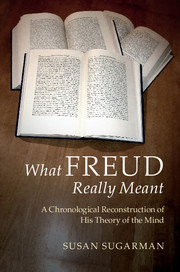What Freud Really Meant A Chronological Reconstruction of his Theory of the Mind
Langue : Anglais
Auteur : Sugarman Susan

This book presents Freud's theory of the mind as an organic whole, built from first principles and developing in sophistication over time.
Through an exacting yet accessible reconstruction of eleven of Freud's essential theoretical writings, Susan Sugarman demonstrates that the traditionally received Freud is the diametric opposite of the one evident in the pages of his own works. Whereas Freud's theory of the mind is typically conceived as a catalogue of uninflected concepts and crude reductionism - for instance that we are nothing but our infantile origins or sexual and aggressive instincts - it emerges here as an organic whole built from first principles and developing in sophistication over time. Sugarman's exciting interpretation, tracking Freud's texts in the order in which he wrote them, grounds his claims in the reasoning that led to them and reveals their real intent. This fresh reading will appeal to specialists and students across a variety of disciplines.
Introduction; 1. Freud on psychoanalysis: 'Five Lectures on Psychoanalysis' (1909a); 2. The pleasure and reality principles: 'Formulations Regarding Two Principles in Mental Functioning' (1911); 'The Psychology of the Dream-Processes' from The Interpretation of Dreams (1900); 3. Ambivalence and the origin of the civilized mind: 'Taboo and Emotional Ambivalence' from Totem and Taboo (1913b); 4. Narcissism as stage in development: 'On Narcissism: An Introduction' (1914); 5. The impetus to the mind: 'Instincts and Their Vicissitudes' (1915a); 6. The possibility of repression: 'Repression' (1915b); 'Negation' (1925a); 7. The unconscious and the structure of the mind: 'The Unconscious' (1915c); 8. Beyond the pleasure principle: 'Beyond the Pleasure Principle' (1920); 9. A new architecture of the mind: 'The Ego and the Id' (1923); 10. Pleasure revised: 'An Economic Problem in Masochism' (1924); 11. Civilization, morality, and the pursuit of pleasure: 'Civilization and its Discontents' (1930); Epilogue: what Freud really meant.
Susan Sugarman, Professor of Psychology at Princeton University, New Jersey, came to the study of Freud as a developmental psychologist who found in Freud's works a striking theory of how the mind develops and a singularly incisive method of argument. She transitioned from studying children to trying to understand the adult mind by looking for the child within it. A former Fulbright scholar and Guggenheim fellow, she is the author of four other books, including Piaget's construction of the child's reality and Freud on the psychology of ordinary mental life.
Date de parution : 04-2016
Ouvrage de 192 p.
15.1x22.8 cm
Date de parution : 04-2016
Ouvrage de 206 p.
15.6x23.5 cm
Disponible chez l'éditeur (délai d'approvisionnement : 14 jours).
Prix indicatif 90,80 €
Ajouter au panierThème de What Freud Really Meant :
© 2024 LAVOISIER S.A.S.



